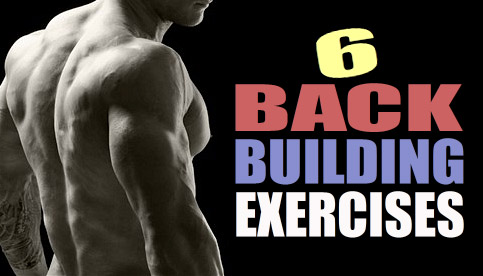6 UNCOMMON EXERCISES FOR A THICK, MUSCULAR BACK

Building a thick, muscular back that really stands out is often quite a challenge for natural trainees.
It’s a set of muscles that can be tough to develop a strong “mind-muscle connection” to without allowing the biceps and forearms to take over a large percentage of the work.
In this post I’ll be covering 6 highly effective but less commonly used exercises that you can experiment with to ramp up the effectiveness of your back training for some additional size and strength gains.
I have covered each of these movements separately in the past, but I wanted to make one post here to condense them all down into one place.
You don’t necessarily have to include all 6 in your back routine, but give each one a try and see which movements work best for you.
Here we go…
Back Exercise #1: Lat Pull-Ins
Unlike a standard pull up or pulldown where the resistance is pulled vertically and downward, this exercise places the resistance directly out to the side of your body where it is then pull inward instead.
To perform the lat pull-in, place a bench or box that you can sit on a few feet away from a cable stand and connect a single pulley attachment to the highest setting on the machine.
From there, extend your arm directly out to your side at roughly a 45 degree angle and grab onto the attachment using an underhand grip.
Tilt your upper body slightly in the direction of the machine, and then pull the resistance inward toward your side until you feel a strong contraction in your lat muscle.
The lat pull-in is an awesome exercise to really hone in on this area because it places the resistance directly in line with the specific angle that the majority of the lat fibers run.
It may take a bit of experimentation to really find the proper form for yourself, but you’ll know when you’ve nailed it because it will almost feel as though your lats are cramping up on each rep.
The feeling should be quite different and much more “lat focused” in comparison to what you regularly experience on your other back exercises.
Back Exercise #2: Seal Rows
It can sometimes be a bit tricky to get the proper setup in place for this one, but the seal row is definitely a worthwhile movement to experiment with if you’re able to.
The basic goal here is to elevate a bench off the ground so that it’s parallel to the floor and high enough that you can lay across it with your arms fully extended below. You can do this using boxes, platforms or whatever else your gym has available.
From this lying position you’ll simply hold onto a pair of dumbbells using a neutral grip, and then row them up towards your body as high as you can until your lats and mid-back muscles are fully contracted.
The seal row is a great back exercise for stimulating hypertrophy since it takes the lower back out of the equation and allows you to place 100% focus on stimulating the targeted lat and mid-back muscles directly.
This is also useful for those with lower back issues who are looking for a good alternative to regular bent over rows, or for those who want to reduce lower back fatigue throughout the week in order to keep the area fresh for bigger compound lifts like squats and deadlifts.
On top of this, the seal row prevents you from using excessive momentum and cheating the weight up, which can often become a problem during other standard free weight rowing movements.
Lastly, having your chin pressed against the bench ensures that you maintain a neutral neck position at all times.
Back Exercise #3: Cable Pullovers
Chances are that you’re probably familiar with the traditional dumbbell pullover, which is a basic “old-school” bodybuilding exercise for hitting the lats.
While this is a decent movement overall when it comes to building a muscular back, the problem with using a dumbbell is that it doesn’t provide constant tension on the lats throughout the entire range of motion.
The lats are fully active in the extended position of the exercise, but because gravity is pulling the weight in a straight line toward the floor, the tension is gradually lost as you pull the dumbbell further and further up toward your chest.
For that reason, a superior option is to perform your pullovers from a standing position using a cable machine. This way your lats will be constantly working from the bottom end of the range all the way to the top.
To perform this back exercise, attach a straight bar to the top of a cable machine and take a couple steps back.
Keep roughly a 30 degree bend in your elbows, and then lean forward while puffing your chest out and maintaining a small arch in your lower back.
From there, pull the cable down in a circular motion until your arms are at your sides and you feel a strong contraction in your lats.
You can experiment with this one during your back workouts by standing a bit closer or further away from the machine until you find the “sweet spot” that maximizes lat activation for you.
You can also test out the cable pullover using a rope attachment as well and see which variation you prefer.
Back Exercise #4: V-Bar Pulldowns
The close-grip v-bar pulldown is a great variation for hitting the lats effectively as well as providing stimulation to the lower and middle traps, rhomboids and serratus.
A lot of people find that using the narrower grip with palms facing in feels more natural in comparison to regular overhand lat pulldowns, so it’s definitely an exercise you’ll want to try out.
Simply attach a v-bar to the top pulley of a lat pulldown machine and then hold onto the bar using a neutral grip.
Sit down on the machine with your legs firmly locked under the pads and lean back slightly at about 30 degrees.
Keep a small arch in your lower back, puff your chest out and retract your shoulder blades slightly in order to increase lat activation.
From there, pull the bar down to your upper chest while keeping your elbows tucked in until you feel your lats fully contract, and then raise the bar back up under control.
Back Exercise #5: Face Pulls
This is an exercise that everyone should be including in their back workouts if possible, as it’s one of the most underrated and underused movements out there.
Face pulls are highly effective when it comes to training the traps and rhomboids, and they also hit the rear delts and rotator cuffs as well.
Not only is this an awesome exercise for building a more muscular back in the mid/upper area, but it’s also a great movement for improving posture and preventing shoulder injuries too.
Face pulls help to externally rotate your shoulders and strengthen your mid-back muscles, which is usually a weak area for a lot of lifters who tend to over-emphasize pressing movements, or for anyone who spends a good portion of their day sitting at a desk in a hunched over position.
To perform face pulls, grab onto a rope attachment and set it at upper chest height on a cable machine.
Rather than gripping the rope from the top with your palms facing down like most people do, grip it from underneath using a neutral hammer grip instead like you see in the video above.
Keep your chest up, shoulders back and retract your shoulder blades, and then pull the rope back toward your face while at the same time pulling the rope apart. A good form cue here is to imagine that you’re trying to hit a “back double bicep pose” on each rep.
Really emphasize control with this one and focus on getting full activation in your upper back muscles as opposed to just yanking the rope back with your hands and forearms.
If you don’t have access to a cable machine then you can perform your face pulls using resistance bands instead.
Back Exercise #6: Bent Over Dumbbell Shrugs
Almost everyone in the gym performs their shrugs in the traditional way of standing completely upright and shrugging their shoulders in a straight up and down motion, but this really isn’t the best way to go about it if you really want to build a muscular back in that upper trap area.
The straight up and down motion actually puts the primary focus on the levator scapulae muscles rather than the trapezius, since, as the name implies, the function of those muscles is to elevate the scapula.
If you want to maximize the tension on your traps, then you’ll actually need to lighten the weight up a bit, bend forward at the waist slightly, and focus on shrugging the weight at a diagonal angle so that your shoulders are moving both up and back toward the mid-line of your body.
Also make sure to keep your neck slightly flexed, and allow your arms to “hang” forward toward the floor in the bottom position until you feel a good stretch in your traps.
This one takes a bit of practice and might feel a bit weird at first, but once you get the form down you’ll definitely feel your traps working a lot harder than they do with standard shrugs.
2 Additional Tips To Get The Most From These Back Exercises

As I mentioned at the beginning of the article, one of the biggest challenges with proper back training is in minimizing the involvement of the biceps and forearms.
These smaller muscles will tend to take over if you aren’t careful, and you can shift more of the stress onto your back muscles with the following two techniques:
- Focus on pulling through your elbows rather than your hands. Just imagine that your forearms are merely “hooks” connecting you to the weight, but that all of the pulling is actually happening through your elbows. This is the single most effective form cue you can use and will go a long way in helping you build a more muscular back that really stands out.
- Utilize a set of lifting straps or hooks. This will help to take your grip out of the equation and allow you to train your back in a more direct, focused way. If building grip strength is a concern for you, then you can simply incorporate some direct grip work separately to take care of that.
If you found these tips for building a muscular back helpful, make sure to get your personalized training, nutrition and supplement plans using my free interactive video presentation below…
If you found this article helpful, make sure to sign up for your FREE custom fitness plan below...




